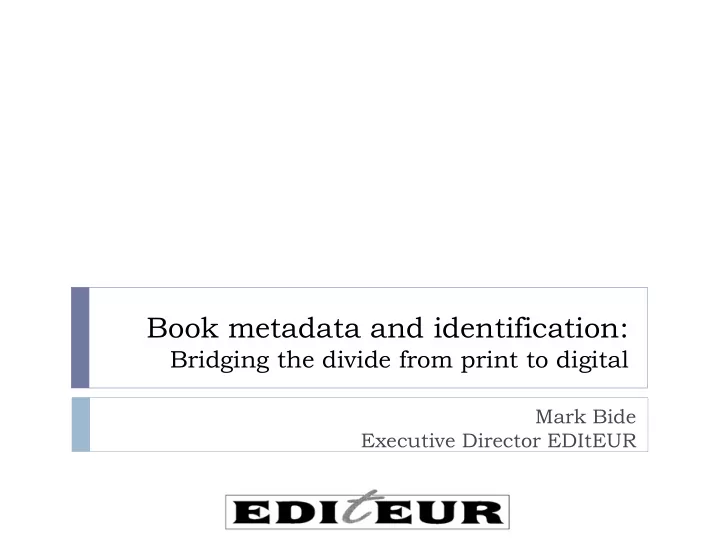

Book metadata and identification: Bridging the divide from print to digital Mark Bide Executive Director EDItEUR
About EDItEUR Not-for-profit membership organisation Our role is to develop, maintain and promote the use of standards in the book and journal supply chains round the world Based in London, global membership Publishers, distributors, wholesalers, subscription agents, booksellers, libraries, system vendors, rights management organisations and trade associations 100 members in over 20 countries US, Japan, China, UK and throughout Europe Governing board of national, regional and international trade organisations to provide strategic direction Provide management services for ISO standards ISBN, ISTC, ISNI
Book industry standards and the physical supply chain Metadata standards are not new to the industry Managing a huge catalog of products: the ISBN Unambiguous identification of “things that are for sale” Managing a huge volume of transactions: EDI X12, EDIFACT, Tradacoms Exchange of commercial transactions Managing a huge volume of metadata: ONIX Exchange of rich descriptions An essential tool as commerce started to move from the physical bookstore to online
What is the International Standard Book Number? ISO 2108 (1970; most recent revision 2005) 13 digit numeric string Includes some – but often misleading – affordance What does an ISBN identify? A book? A class of books – a product
Book industry standards and the physical supply chain Metadata standards are not new Managing a huge catalog of products: the ISBN Unambiguous identification of “things that are for sale” Managing a huge volume of transactions: EDI X12, EDIFACT, Tradacoms Exchange of commercial transactions Managing a huge volume of metadata: ONIX Exchange of rich descriptions An essential tool as commerce started to move from the physical bookstore to online
What is ONIX for Books? XML communication format for sharing book industry product information Originated 1999 by the American Association of Publishers Current status: v2.1 widely implemented, v3.0 growing Implemented in many countries throughout the world – most recently Japan, China, Egypt, Turkey Allows the communication of information about publishers’ products throughout the supply chain – to distributors, wholesalers, retailers and other partners In many markets, data is collected from many sources and redistributed in consolidated form to supply chain partners Used by small and large organisations, included in many off the shelf IT systems
What do these standards have in common? Unashamedly, they are all about commerce Metadata and messaging standards are not simply about discovery – they are required for all aspects of commerce Helping people to find and buy things is a key driver of ONIX distribution…but there is lots more in an ONIX message Commerce is not constrained by borders or language Standards reflect that reality
ONIX and language Language of the standard and of the supporting documentation is English – although many national groups have their own translations No constraints on the use of character sets or reading direction Active implementations in Japan, China, Korea, Russia, Egypt, Turkey, Bulgaria The codes are a language-independent notation – identifiers for concepts When an ONIX message crosses borders, the tokens continue to convey the same meaning
Downloadable ebook EPUB Fixed format No online components OS requirements Required OS Required OS Primarily text With both audio and video components
What metadata does ONIX for books communicate? Identity and authority Publishing, including Record details Imprint and publisher Product identifiers Publication date T erritorial Rights Descriptive, including Related material, including Product form Related works Classifications Titles Related products Contributors Supply, including Edition Availability Language Suppliers Subject Prices Audience Discounts Collateral, including Marketing resources Supporting text
From physical to digital – a mixed economy Metadata and identity are the “lifeblood of ecommerce” The core challenge is the increased complexity…. ….of identification, of description, of transaction Metadata is as complex as the world it seeks to describe… … “simplification” of metadata = loss of information
Industry systems are not designed to deal with this complexity ISBN is a product identifier – but has been used as the primary key of many systems that have nothing to do with products Definition of “a product” has become more difficult Hardback, paperback….ebook? The potential number of products has become an order of magnitude greater How do you collocate all these different products? A work identifier (ISTC)? A “release” identifier? How far do we have to manage instance identification? The equivalent of RFID – already required for management of DRM
Managing the metadata explosion All metadata is essentially about identity Particularly if it is to be unambiguously machine-processable Essential for a commercial environment Public identification systems are not primarily technical but social – agreed upon norms and processes Unambiguous rules for what is identified Unambiguous rules of granularity – when are two things treated as being “the same thing” and when as different To be useful, public identification systems require publically accessible registries – so that others can know what is being identified Books in Print – registries are not always “freely available”
The creation and management of authoritative metadata is never costless Common, authoritative metadata databases, if they are well run and maintained, will save costs for everyone… …but inaccurate, inconsistent and out-of-date metadata may be worse than no metadata at all Traditional systems for managing metadata and identity in publishing are no longer viable We don’t deal simply in products Metadata itself is a service not a good It needs to be managed on an ongoing basis, not just manufactured once “Metadata should be free” is too simplistic There are costs associated with metadata creation and management that someone has to pay
Some questions I would like to hear answered eBook identification What are the classes of referents we need to identify? eBook metadata: in-band or out-of band What should be embedded and what associated by external reference? Convergence between commercial and library practice Can we share metadata more effectively?
Book metadata and identification: Bridging the divide from print to digital mark@editeur.org
Recommend
More recommend